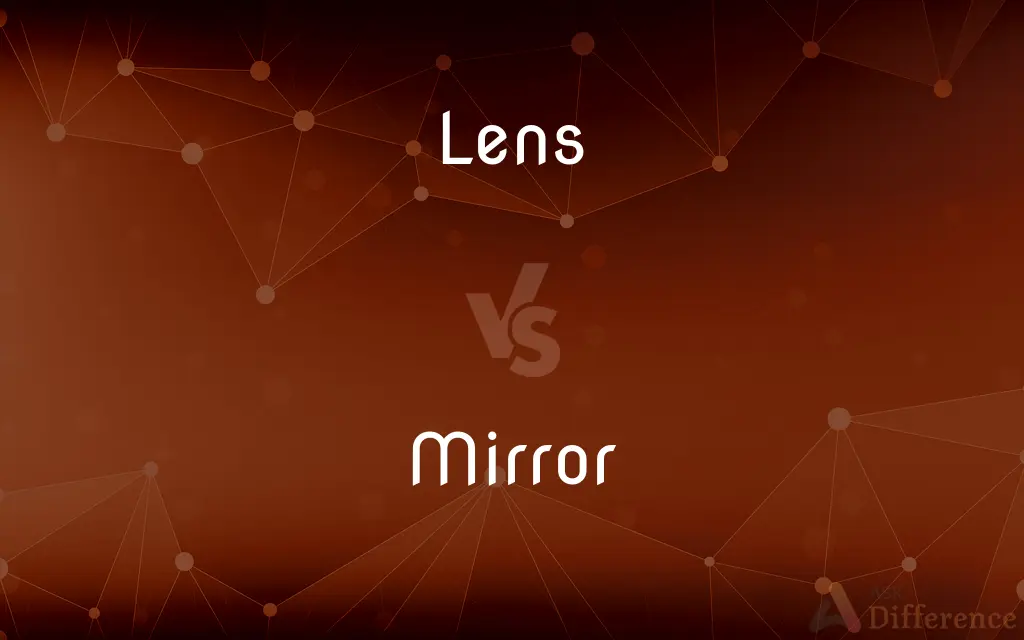Lens vs. Mirror — What's the Difference?
By Urooj Arif & Fiza Rafique — Updated on May 14, 2024
Lenses focus light through refraction using transparent materials, creating images by bending light; mirrors reflect light using a reflective surface, forming images by bouncing light back.

Difference Between Lens and Mirror
Table of Contents
ADVERTISEMENT
Key Differences
A lens is a piece of transparent material, usually glass or plastic, shaped to converge or diverge light through refraction. Whereas mirrors are objects with a reflective surface, often coated with a metal such as aluminum, that reflects light without transmitting it.
While lenses are used to adjust the focus of light to form magnified or diminished images, mirrors reflect light at specific angles to create images that are equal in size to the object but reversed. On the other hand, the image produced by a lens can vary significantly in size, orientation, and clarity depending on the lens type.
Lenses are crucial in applications where light must be manipulated precisely, such as in cameras, eyeglasses, and microscopes. In contrast, mirrors are often used where light needs to be redirected without alteration in its path, such as in telescopes, vehicles, and various optical instruments.
The effectiveness of a lens depends on its curvature and the refractive index of the material, while the effectiveness of a mirror depends largely on the quality of its reflective coating and the accuracy of its surface shape. Whereas a lens can suffer from aberrations that distort the image, a mirror might deal with issues like tarnishing or de-silvering that affect reflectivity.
Lenses can transmit light and therefore can handle light from transparent or translucent objects. Mirrors, however, require existing light to reflect and are thus limited to reflecting images of objects that are illuminated by other light sources.
ADVERTISEMENT
Comparison Chart
Function
Refracts light to focus or spread beams
Reflects light to form images
Image formation
Through light transmission and refraction
Through light reflection
Material
Transparent (glass, plastic)
Reflective surface (metallic coating)
Image characteristics
Can be real or virtual, magnified or reduced
Always virtual, same size, laterally inverted
Uses
Cameras, eyewear, microscopes
Telescopes, rear-view mirrors, decor
Compare with Definitions
Lens
A curved piece of transparent material that bends light.
The photographer adjusted the lens to get a clearer shot.
Mirror
Essential in vehicles for visibility and safety.
The driver adjusted the rear-view mirror before starting the car.
Lens
Prone to aberrations which can distort images.
Lens aberrations were minimized using advanced optical coatings.
Mirror
Typically used for viewing, decoration, or in instruments.
The hallway was decorated with several large mirrors.
Lens
Used to focus or spread light beams in various devices.
He used a magnifying lens to inspect the fine print.
Mirror
May degrade over time, affecting the reflection quality.
The old mirror's reflection was marred by black spots from de-silvering.
Lens
A ground or molded piece of glass, plastic, or other transparent material with opposite surfaces either or both of which are curved, by means of which light rays are refracted so that they converge or diverge to form an image.
Mirror
A mirror is an object that reflects an image. Light that bounces off a mirror will show an image of whatever is in front of it, when focused through the lens of the eye or a camera.
Lens
A combination of two or more such pieces, sometimes with other optical devices such as prisms, used to form an image for viewing or photographing.Also called compound lens.
Mirror
A surface, typically of glass coated with a metal amalgam, which reflects a clear image
He checked his appearance in the mirror
Lens
A thin piece of glass or plastic, as on a pair of sunglasses, that transmits light without refraction.
Mirror
(of a surface) show a reflection of
The clear water mirrored the sky
Lens
A device or phenomenon (such as a gravitational field) that causes light or other radiation to converge or diverge by an action analogous to that of a lens.
Mirror
A surface capable of reflecting sufficient undiffused light to form an image of an object placed in front of it. Also called looking glass.
Lens
A transparent, biconvex structure in the eye of a vertebrate or cephalopod that is located between the iris and the vitreous humor and focuses light rays entering through the pupil to form an image on the retina.
Mirror
Something that faithfully reflects or gives a true picture of something else.
Lens
A similar structure in many invertebrates.
Mirror
Something worthy of imitation.
Lens
(Informal)To make a photograph or movie of.
Mirror
To reflect in or as if in a mirror
"The city mirrors many of the greatest moments of Western culture" (Olivier Bernier).
Lens
To bend or distort (light, for example) by means of a lens, especially a gravitational field.
Mirror
A smooth surface, usually made of glass with reflective material painted on the underside, that reflects light so as to give an image of what is in front of it.
Lens
An object, usually made of glass, that focuses or defocuses the light that passes through it.
Mirror
(figuratively) An object, person, or event that reflects or gives a picture of another.
Lens
A device which focuses or defocuses electron beams.
Mirror
A disk, website or other resource that contains replicated data.
Lens
(geometry) A convex shape bounded by two circular arcs, joined at their endpoints, the corresponding concave shape being a lune.
Mirror
A mirror carp.
Lens
(biology) A genus of the legume family; its bean.
Mirror
(historical) A kind of political self-help book, advising kings, princes, etc. on how to behave.
Lens
(anatomy) The transparent crystalline structure in the eye.
Mirror
(transitive) Of an event, activity, behaviour, etc, to be identical to; to be a copy of.
Lens
(earth science) A body of rock, ice, or water shaped like a convex lens.
Mirror
To create something identical to (a web site, etc.).
Lens
(programming) A construct used in statically-typed functional programming languages to access nested data structures.
Mirror
(transitive) To reflect, as in a mirror.
Lens
A way of looking, literally or figuratively, at something.
Mirror
A looking-glass or a speculum; any glass or polished substance that forms images by the reflection of rays of light.
And in her hand she held a mirror bright,Wherein her face she often viewèd fair.
Lens
To film, shoot.
Mirror
That which gives a true representation, or in which a true image may be seen; hence, a pattern; an exemplar.
She is mirour of all courtesy.
O goddess, heavenly bright,Mirror of grace and majesty divine.
Lens
(geology) To become thinner towards the edges.
Mirror
See Speculum.
Lens
A piece of glass, or other transparent substance, ground with two opposite regular surfaces, either both curved, or one curved and the other plane, and commonly used, either singly or combined, in optical instruments, for changing the direction of rays of light, and thus magnifying objects, or otherwise modifying vision. In practice, the curved surfaces are usually spherical, though rarely cylindrical, or of some other figure.
Mirror
To reflect, as in a mirror.
Lens
A transparent optical device used to converge or diverge transmitted light and to form images
Mirror
To copy or duplicate; to mimic or imitate; as, the files at Project Gutenberg were mirrored on several other ftp sites around the world.
Lens
Genus of small erect or climbing herbs with pinnate leaves and small inconspicuous white flowers and small flattened pods: lentils
Mirror
To have a close resemblance to; as, his opinions often mirrored those of his wife.
Lens
(metaphor) a channel through which something can be seen or understood;
The writer is the lens through which history can be seen
Mirror
Polished surface that forms images by reflecting light
Lens
Biconvex transparent body situated behind the iris in the eye; it focuses light waves on the retina
Mirror
A faithful depiction or reflection;
The best mirror is an old friend
Lens
Electronic equipment that uses a magnetic or electric field in order to focus a beam of electrons
Mirror
Reflect as if in a mirror;
The smallest pond at night mirrors the firmament above
Lens
Can create magnified images of small or distant objects.
The microscope's lens magnified the cells up to 1000 times.
Mirror
Reflect or resemble;
The plane crash in Milan mirrored the attack in the World Trade Center
Lens
Found in everyday items like glasses and cameras.
Her glasses had lenses specially crafted to correct her vision.
Mirror
A surface that reflects light to form an image.
She looked in the mirror to check her outfit.
Mirror
Creates a virtual image that appears behind the plane of the mirror.
The mirror on the wall reflected a virtual image of the room.
Common Curiosities
How does a lens form an image?
By bending (refracting) light rays that pass through it, focusing them to form an image.
Can mirrors form real images?
Typically, mirrors form virtual images, but concave mirrors can form real images under certain conditions.
Why do mirrors not change the color of reflected images?
Mirrors reflect all wavelengths of light equally without absorbing any, thus maintaining the original colors of the object.
What materials are used to make lenses?
Common materials include glass and various types of plastic, each chosen for its optical properties.
What is the primary use of lenses in everyday life?
Lenses are widely used in eyeglasses, cameras, and other optical devices to correct vision or focus light.
What are aberrations in a lens?
Aberrations are defects in a lens that cause light rays to spread out or focus imperfectly, distorting the image.
Can a lens reflect light like a mirror?
While lenses primarily refract light, they can also reflect a small amount due to their polished surfaces.
How can the quality of a mirror's reflection be preserved?
By protecting the reflective coating from oxidation and physical damage, often with a protective backing or sealant.
How are mirrors made to reflect light?
By applying a reflective coating, typically silver or aluminum, to the back surface of a piece of glass.
What are some creative uses of mirrors in design?
Mirrors are used to enhance lighting, create an illusion of space, and as decorative elements in interiors.
Share Your Discovery

Previous Comparison
Withdraw vs. Drawdown
Next Comparison
Work vs. ServiceAuthor Spotlight
Written by
Urooj ArifUrooj is a skilled content writer at Ask Difference, known for her exceptional ability to simplify complex topics into engaging and informative content. With a passion for research and a flair for clear, concise writing, she consistently delivers articles that resonate with our diverse audience.
Co-written by
Fiza RafiqueFiza Rafique is a skilled content writer at AskDifference.com, where she meticulously refines and enhances written pieces. Drawing from her vast editorial expertise, Fiza ensures clarity, accuracy, and precision in every article. Passionate about language, she continually seeks to elevate the quality of content for readers worldwide.
















































